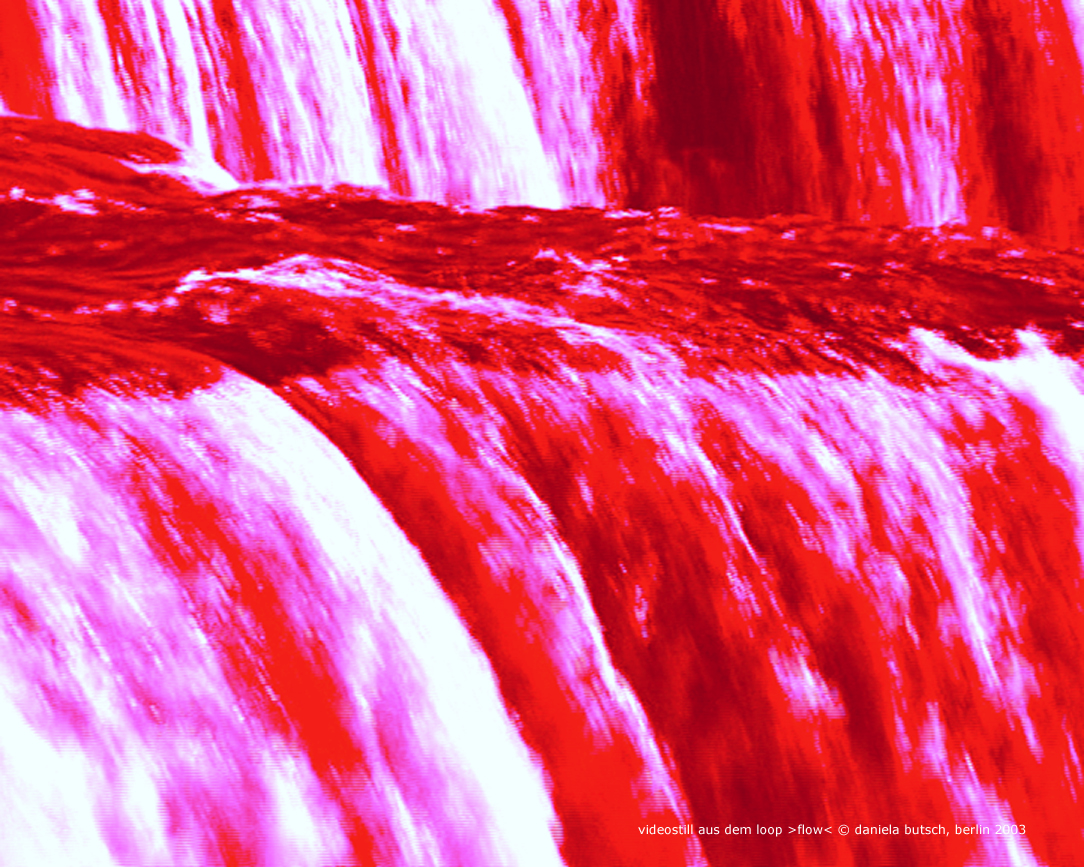About Daniela Butsch’s video installation “flow”
by Peter Funken
Water, nothing other than flowing, teeming, rushing water – no meager trickle out of the tap, no languid canal and also no river flowing leisurely along, but unbelievable masses of water, plunging cascades and waves of water; this is what Daniela Butsch shows in her moving image sequence “flow” finished in 2003.
Butsch filmed “flow” at the Niagara Falls in the USA and Canada. “flow” shows in a stationary shot the flowing movements of water and the power, intensity and calm of this element.
Butsch’s electronic images show in the foreground masses of water flowing down a step; from the left and intersecting the center of the image further streams of water force themselves on, whilst in the background a surging tide can be seen. This shot and perspective remains fixed throhout the duration of the film. It is a clear image composition, full of tension filling the whole image space. The arrangement of background, middle and foreground reveals something absolute that seems dynamic yet meditative.
Daniela Butsch understands “flow” quite rightly to be “electronic painting”, as her filming of the Niagara Falls is enhanced by color and through medial connotation. Butsch’s video– after initially rapidly picking up speed from the silence and calm of the still image – passes through all the colors of the color circle including its intermediate colors, starting with red, until the film finally ends in a shade of magenta. Much has happened up to this point – the view of the flowing water has changed from orange to yellow into green and blue, to become purple and finally pink. The color changes lend the work again and again a different new mood and atmosphere: “flow” begins in a pale warm red, becoming an almost menacing and bloody red, then cooling and turning cold with the color blue. The apparently seamless color changes produce moments, which can hardly be grasped or described. The intermediate colors develop contrasts, blurs and transformations that can certainly be perceived by the eye, but the shift in meaning they produce scarcely manifests itself in the intellect upon a first viewing of the film. Moreover “flow” changes the direction of movement after the first half of its running time*, just over six minutes in. After the first half, the water no longer flows and falls downwards obeying gravity, but now climbs back up to its source. The two opposing flow directions are broken up by a slowing down phase that culminates in a standstill of a few seconds in length. This backward movement gives the film a peculiar form of perception that provides the viewer with another and different chance to “access” “flow”: If the first half rapidly revealed its suggestive effect in a very intensive way, pulling the viewer under its spell or in its wake – by all means an intoxicating experience, the effect
of the water flowing backwards creates a new and additional irritation, thus removing the image even further than before from any reference to reality. With the water flowing backwards the film reality really enters the realm of the fantastic, except that – and this strikes me as remarkable – the power of suggestion evoked by the flowing water and the color changes have already built up to such an extent that as a viewer one can scarcely account for the very different degrees of how reality is presented. After a short time one somehow begins to flow along with it, thereby becoming an element of the film. “flow” produces in this way a new, complex and fascinating form of reality that has its origins in a natural phenomenon. However it does not stop there, but leads to a medial experience that stimulates viewers to see, and integrates them in what is happening. It is left up to the individual viewer how to deal with this experience – to perceive it as a purely sensual-emotional experience or to understand it to be an impulse for questioning the reality of reality. In this sense, Daniela Butsch’s “flow” is an open work of art, concrete in form, but in terms of meaning leaving a great deal of scope for variations in approach and interpretation.
The “flow” master tape has a length of more than 12 minutes, which can be extended by looping it. This basic form varies according to the projection location and context, whereby “flow” can be installed both indoors and outdoors. In my view the ideal projection location is outdoors, as the entire power, intensity and elegance of “flow” as a wall projection unfolds best in a larger dimension. Daniela Butsch understands “flow” to be a context-oriented concept, with a variable length and projection size.
Dr. Peter Funken
born 1954 in Heinsberg / Rheinland, he has lived in Berlin since 1983. He is a freelance writer and curator.
He is currently working for the Northern European Academy for Art and Architecture in Schwerin, Germany.
